Key takeaways:
- STIs impact both physical health and emotional well-being, emphasizing the importance of open discussions and support networks to reduce stigma and foster understanding.
- Regular STI testing and honest communication with partners are essential for prevention and early intervention, promoting healthier relationships and community awareness.
- Treatment options vary by infection type, with many STIs being curable; ongoing care and education are crucial for managing chronic conditions and overcoming stigma.
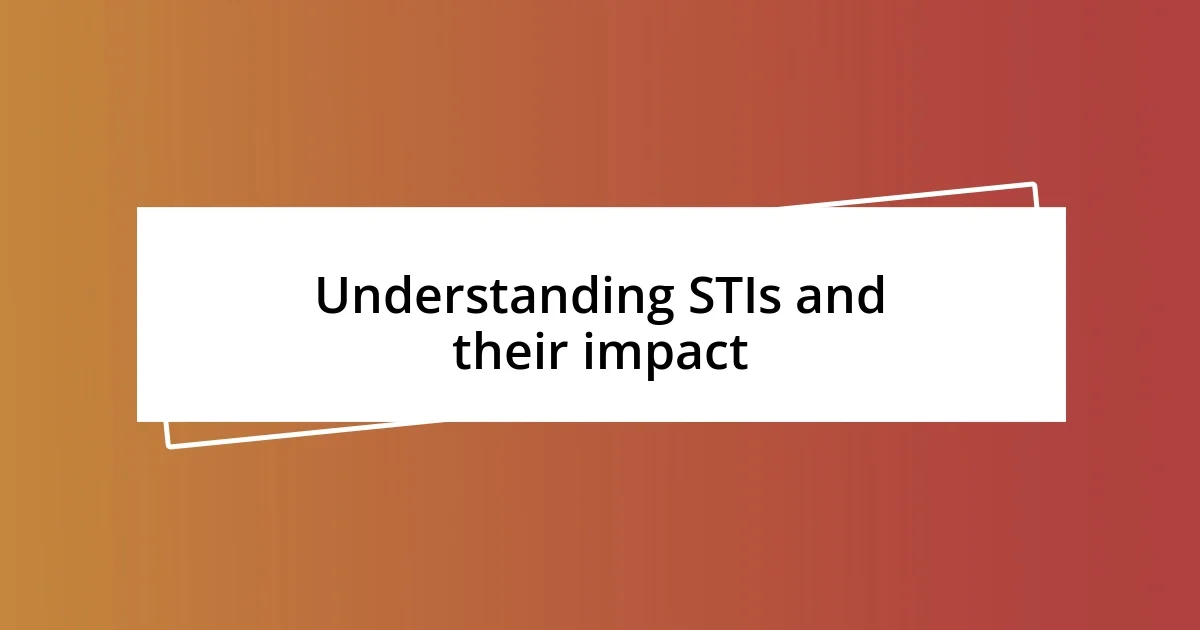
Understanding STIs and their impact
When it comes to understanding STIs, it’s crucial to grasp how they not only affect physical health but also emotional well-being. I recall a conversation with a friend who was battling anxiety after receiving an STI diagnosis. It made me realize just how intertwined our mental and emotional states are with our sexual health. Isn’t it interesting how a single piece of news can ripple through every aspect of your life?
The impact of STIs goes beyond individual experiences; it can affect relationships and even community dynamics. For me, learning about STIs led to some candid discussions with partners, which ultimately brought us closer. Have you ever considered how open conversations about sexual health can strengthen connections? It’s fascinating to think about how sharing fears and knowledge can transform our experiences.
Additionally, the social stigma surrounding STIs can amplify feelings of shame or isolation for those affected. I once attended a workshop where individuals shared their stories, and it struck me how important support networks are. How can we foster more inclusive conversations about STIs that help dismantle this stigma? Creating a safe space for dialogue might just be the key to transforming fear into understanding and support.

Common types of STIs to know
There are several common types of sexually transmitted infections (STIs) that everyone should be aware of. Personally, I remember the first time I learned about chlamydia and gonorrhea in a health class; the reality of how prevalent they are made me think twice about safe practices. These infections can often go unnoticed because they don’t always show symptoms, leading to potential complications if left untreated. Here are some of the most common STIs to know:
- Chlamydia: Often asymptomatic, it can lead to serious reproductive issues if not treated.
- Gonorrhea: Similar to chlamydia, it can affect the genital tract, rectum, or throat, often requiring antibiotic treatment.
- Syphilis: Early stages are usually mild, but if untreated, it can progress to severe health problems.
- Herpes (HSV): Characterized by painful sores, this is a lifelong infection with periods of outbreaks and remission.
- Human Papillomavirus (HPV): The most common STI, some types can lead to cancer, while others might not show symptoms at all.
Another STI that caught my attention was HIV. I distinctly recall an educational seminar where a survivor shared their journey, highlighting the advances in treatment that allow individuals to lead healthy lives. This really shifted my perspective on how far we’ve come in managing STIs. It deepened my understanding of the importance of regular screenings and conversations about sexual health. Here’s a quick breakdown of a few other significant STIs:
- HIV/AIDS: A virus that attacks the immune system, but with modern treatments, those living with it can manage their health effectively.
- Trichomoniasis: A parasite that can cause discomfort but is easily treated with medication.
- Hepatitis B and C: Viruses affecting the liver, both of which can be serious but can be managed with proper care and prevention strategies.
Knowing these types and recognizing their symptoms can empower us to seek treatment early, fostering healthier lives and relationships.
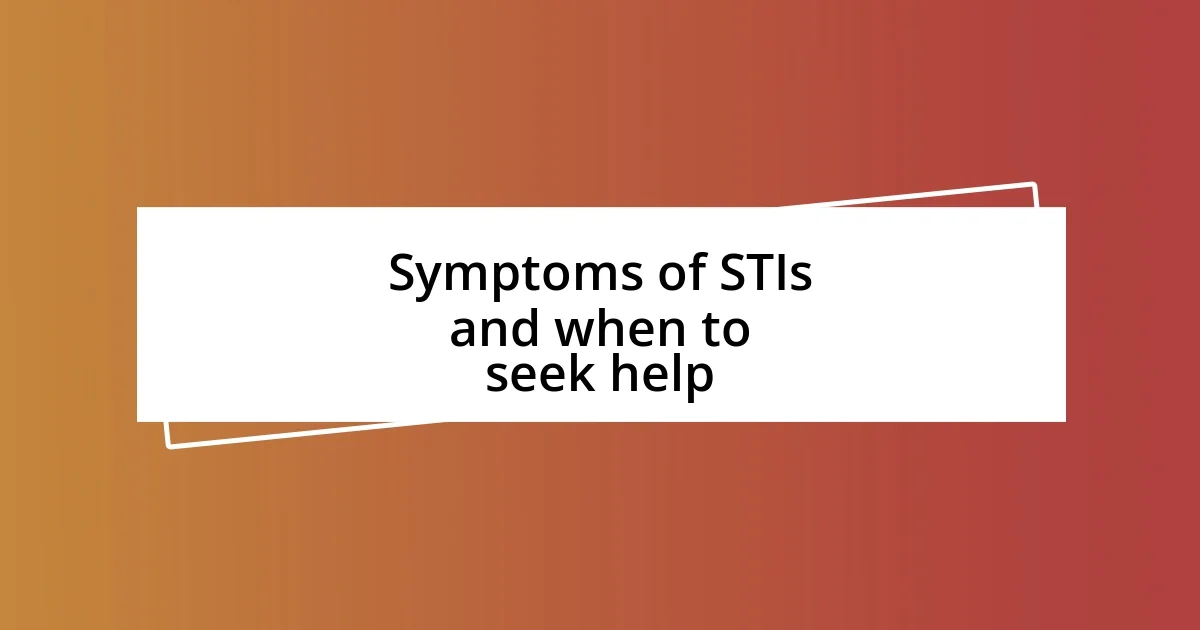
Symptoms of STIs and when to seek help
When it comes to STIs, recognizing the symptoms is vital for timely intervention. I’ll never forget the moment I experienced unusual discomfort; it prompted me to seek medical advice. Common symptoms might include unusual discharge, itching, or pain during urination, but many infections can be asymptomatic. So, if anything feels off, it’s better to err on the side of caution and get checked out.
The timing of seeking help can significantly impact treatment outcomes. For instance, I have friends who waited too long, thinking symptoms would resolve on their own, only to face more complicated health issues later. If you notice consistent symptoms or have engaged in activities that put you at risk, visit a healthcare provider sooner rather than later. It could save you from chronic complications, and I’ve learned that the earlier you address these concerns, the lighter the emotional burden becomes.
Having an open conversation about symptoms can also bring reassurance. I recall discussing these issues with a partner, which made us both feel more empowered to seek help. Remember, reaching out for assistance is a sign of strength, not weakness. Here’s a quick overview of some specific symptoms associated with major STIs and appropriate actions to take:
| STI | Common Symptoms |
|---|---|
| Chlamydia | Often asymptomatic; burning sensation during urination, abdominal pain |
| Gonorrhea | Similar to chlamydia; unusual discharge, pain during sex |
| Syphilis | Painless sores in the initial stage, skin rashes later |
| Herpes | Painful sores or blisters, flu-like symptoms during outbreaks |
| HPV | Warts on genital areas; most strains show no symptoms |
| HIV | Flu-like symptoms; chronic fatigue, persistent fever |
| Trichomoniasis | Itching, burning, unusual discharge |
| Hepatitis B and C | Fatigue, jaundice, abdominal pain |
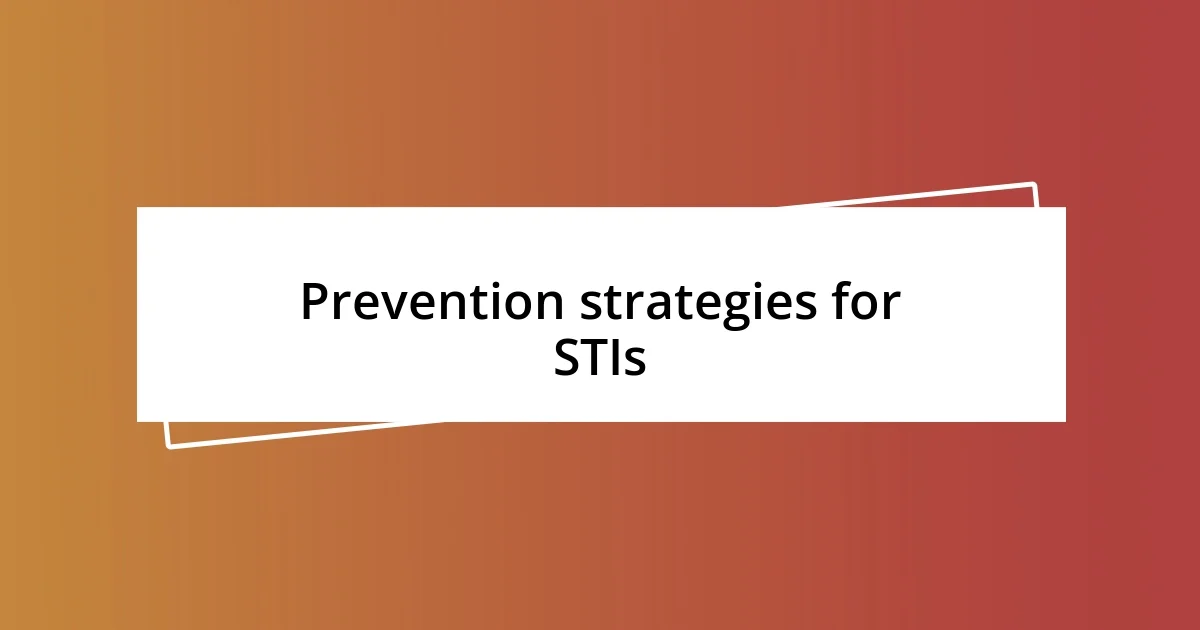
Prevention strategies for STIs
When it comes to preventing STIs, one of the most effective strategies is consistent use of protection, such as condoms. I’ve often shared with friends how this simple act can dramatically reduce the risk of transmission. It’s amazing to think about how many people underestimate the power of a barrier; it genuinely empowers both partners to prioritize their health.
Another crucial strategy is regular testing. I remember feeling a mix of nervousness and relief the first time I got tested. The process isn’t just about confirming your own health; it’s about being responsible for the well-being of others too. It’s important to ask yourself: when was the last time you got tested? It’s never too late to make it a habit, and the peace of mind it brings can be transformative.
Open communication with partners about sexual history and preferences is essential as well. I’ve found that maintaining an honest dialogue fosters a sense of trust and safety. It can be awkward at first, but asking questions about each other’s sexual health helps build a solid foundation for any relationship. After all, isn’t it better to have that conversation early on than to deal with the potential fallout later?
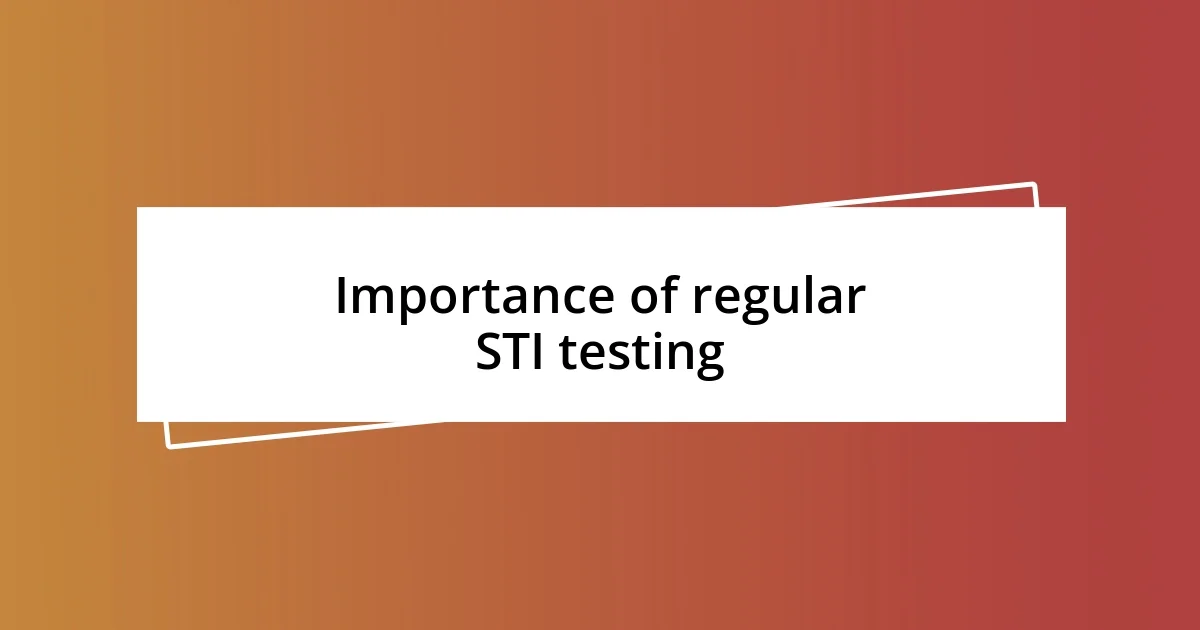
Importance of regular STI testing
Regular STI testing is essential, and I can personally attest to its importance. I once put off testing for too long, thinking I was invulnerable. When I finally did get tested, I experienced a wave of relief knowing my status, which sparked a commitment to make it a routine part of my health care. Isn’t it comforting to know you’re taking control?
It’s fascinating how routine testing can lead to positive conversations. I remember when I and a partner went for testing together. It not only reinforced our commitment to honesty but also deepened our emotional bond. We both felt empowered by the act itself, as if we were taking a stand for our health and future. Why wait for a problem to arise when you can be proactive?
Think about the broader impact of testing too. Every time you get tested and learn your status, you help prevent the spread of STIs. I often reflect on how my choices might influence others’ health. It’s not just about you; it’s about everyone you care about. Wouldn’t you want the same reassurance for them? Prioritizing regular testing can create a ripple effect, fostering a community of awareness and responsibility.

Treatment options for STIs
When it comes to treating STIs, options can vary significantly based on the type of infection. I recall when I was diagnosed with chlamydia; the doctor prescribed a simple course of antibiotics. It was a relief to know that a few pills could effectively eliminate the infection without complicated procedures. That experience really drove home the fact that not all STIs are a lifelong sentence—many are curable.
For viral infections like HIV or herpes, the approach is quite different. I still remember the weight I felt learning about lifelong management and antiviral medications. It made me reflect on the importance of continuous care and adherence to treatment plans. How many of us realize that these medications can significantly reduce viral loads and even prevent transmission? It’s empowering to know that with the right treatment, individuals can lead healthy lives.
An equally important aspect is follow-up care. I once visited my healthcare provider a few months after treatment, feeling a mix of curiosity and anxiety. That check-in reassured me that I was on the right path and highlighted the importance of monitoring overall health. Isn’t it vital that we view treatment not just as a one-time fix but as part of ongoing health management? Life after an STI diagnosis can indeed include hope and empowerment if we stay engaged with our health.
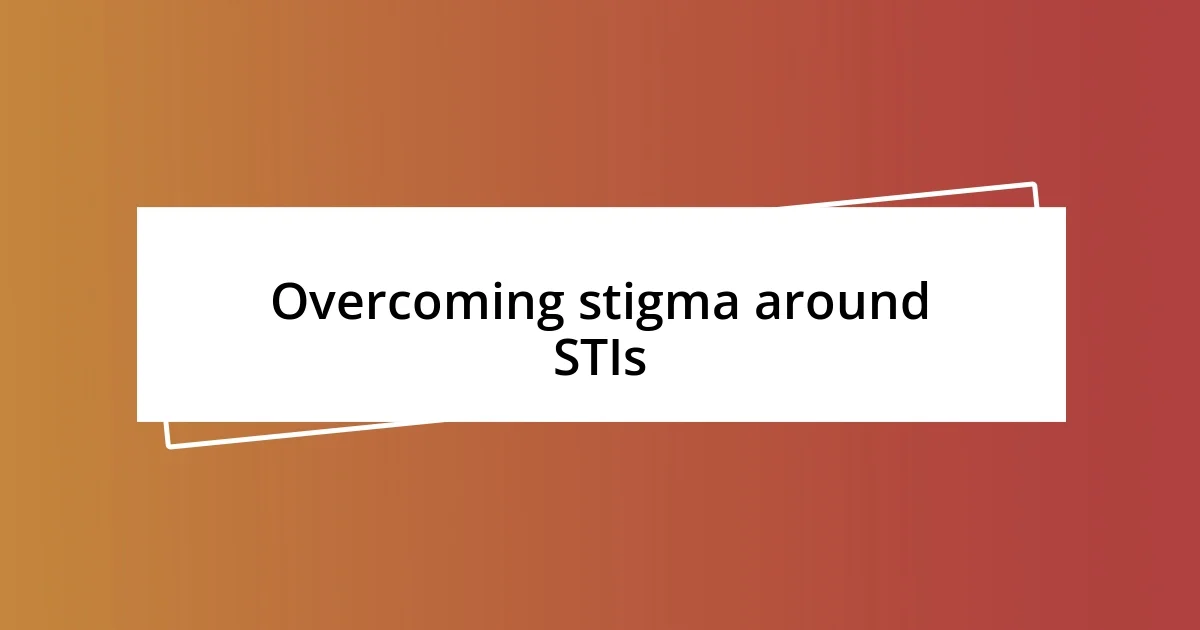
Overcoming stigma around STIs
Overcoming stigma around STIs is vital for fostering open conversations and reducing shame. I remember feeling anxious the first time I shared my STI history with a close friend. To my surprise, they responded with empathy, which opened the door for an honest discussion about our experiences. This exchange made me realize how often the fear of judgment holds us back, even when vulnerability can lead to connection.
When we choose to talk about STIs openly, we challenge misconceptions and break down barriers. A few months ago, I participated in a community health event where people shared their stories. I was struck by how liberating it felt to hear others’ struggles and triumphs; it was as if we were all peeling back layers of stigma together. Isn’t it incredible how shared experiences can foster understanding and support?
Education plays a crucial role in dispelling the fear surrounding STIs. I often seek out resources and attend workshops that emphasize not just the medical aspects but also the emotional journey that comes with an STI diagnosis. By empowering ourselves with knowledge, we can approach these conversations with confidence and help others feel less alone. After all, isn’t it better to live without the burden of shame?












